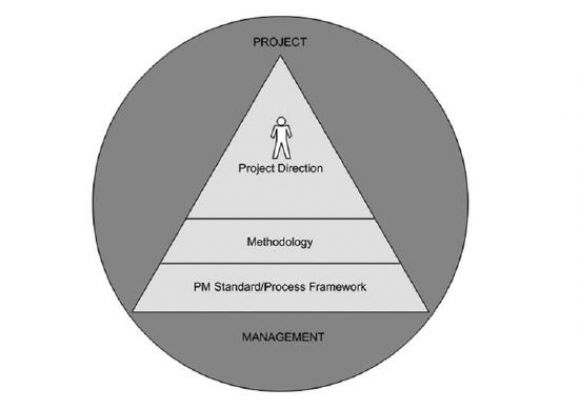A project without a project manager is like an orchestra without a conductor.
Editor's Note: This article is excerpted from chapter 1 of Fundamentals of Technology Project Management, by Colleen Garton and Erika McCulloch.
You can have the best musicians (or engineers) in the world, but without the leadership of a talented conductor (or manager) who understands how everyone’s piece must fit precisely together, in the right order, to produce the final product, the orchestra (or the team) is not going to perform well and the results will be poor.
A Project Manager’s Value to an Organization
To realize its full potential for a great symphony or a great technology product, a team needs direction and guidance from a leader who can see the “big picture” but understands enough about the details to be able to lead the team to success.
In technology, this person is the project manager. The project manager’s value to the organization is the same value that the conductor brings to the orchestra. Just as successful orchestras would not dream of performing a concert without one, successful companies should not dream of launching a project without a project manager. It happens, but fortunately not as often these days as in the past. Companies have learned their project nightmare lessons! The project manager is the glue that holds the project team together. It is a vital role and carries with it a lot of responsibility. The success of a project is determined primarily by the quality of the project manager. Never underestimate the value that the project manager brings to the team or to the project results.
The Difference Between a Project, Program, and Portfolio
A project is an undertaking to create a product, service, or process. Though different variations of the product, service, or process may be included as part of one project, those variations are based on the core project objective. For example, a project may produce a product that is available in five different colors, sizes, or languages. These variations could be split into separate projects, but if the bulk of the project work is the same, it would usually be considered one project.
A program is a collection of projects that have been grouped together because it is beneficial to manage them in a coordinated way. The projects may not be related from a business perspective, but it makes sense to group them into a program for project management purposes. For example, the projects may share common components. It may be beneficial to leverage or reuse technology from one project for another. Similar skill sets may be required across multiple projects, so those projects would be grouped into a program to enable development schedules to be coordinated appropriately. A project may not be part of a program, but a program will always comprise more than one project. A project manager may manage multiple projects within a program or may manage just one. A program manager is responsible for the high-level management and coordination of the projects within the program. The program manager has overall responsibility for the success of the program and, therefore, for each project within the program.
A portfolio is a collection of products, projects, programs, services, or other work that is grouped together at the business level for strategic business reasons. The projects or programs may not be directly related and may not have any interdependencies at the project-development level. A portfolio manager may be a business manager or a project manager. The portfolio manager’s focus is on making sure that the portfolio has the right mix of components, features, or projects to meet specific business objectives. A project or product portfolio can be likened to an investment portfolio. For example, an investment portfolio often contains a diversified collection of dissimilar investments. The investments are in different market sectors and have different strategies and goals. Some may be focused on growth, others on income. An investment portfolio may contain a mix of products, such as stocks, bonds, mutual funds, and real estate investments. They include foreign and domestic investments, long-term and short-term investments, low-risk and high-risk investments, and so on. The reason the financial investments are managed as one portfolio is because the combination of investments is required to meet the investment goals of the investor. A project or product portfolio is managed in a similar way and for similar reasons. A portfolio view of projects, products, and/or services enables an organization to make sound business decisions that enable the organization to meet strategic business objectives. An organization may have just one project portfolio for all projects or a collection of portfolios with different portfolio managers.
The Structure of Project Management
Project management can be divided into three distinct areas (see Figure 1.1):
- Standard/Framework
- Methodology
- Project Direction
Figure 1.1: Three Areas of Project Management
Standards/Frameworks
Project management standards/frameworks are generally not designed to be industry specific. Some quality management standards are industry specific. More than one standard can be applied to a project at the same time. There are various standards/frameworks that can be applied to the management of projects. A standard is a framework within which the project is managed and implemented. A project management or quality standard is used to ensure quality and consistency throughout the life of a project. Not all organizations use standards/frameworks for project management. As the project management discipline is maturing, it is becoming more common for standards/frameworks to be applied. Standards are explained in more detail in the next chapter.
Methodology
Project management methodologies are generally designed to be industry specific. Some methodologies may be designed in a modular fashion so you can choose the modules that apply to your specific industry. A methodology needs to be tailored to fit the type of project you are implementing. For example, you would need a different methodology for a construction project than for a software project. The methodology included in this book is designed specifically for technical/IT projects. There are many project management methodologies in use. Some are widely used methodologies, and others are proprietary methodologies created for use by individual organizations. A methodology details what will happen, and when, throughout the life of a project. It organizes the project methodically and defines the steps that need to be followed to complete it.
Project Direction
Project direction is the management and coordination of the standards, methodology, tasks, and people who are part of the project. “People” refers to everyone who is involved in your project. This includes your project team, steering committee, executive management, stakeholders, project managers, people managers, the client, vendors, partners, support personnel, and anyone else who is involved with your project in any way. Project direction is taking the individual parts and bringing them together to form the whole. It is the conductor, coordinating the musicians and instruments to perform a perfect symphony.
Project management involves the management of all three areas. This includes applying the standards, following the methodology, and directing the project by effectively managing the people.
This book includes a methodology. It explains what you need to do and exactly how to do it. It includes information on how to successfully direct a project. This includes the management and coordination of team members’ tasks and the growth and development of individuals.



























 More than ever, there is a demand for IT to deliver innovation. Your IBM i has been an essential part of your business operations for years. However, your organization may struggle to maintain the current system and implement new projects. The thousands of customers we've worked with and surveyed state that expectations regarding the digital footprint and vision of the company are not aligned with the current IT environment.
More than ever, there is a demand for IT to deliver innovation. Your IBM i has been an essential part of your business operations for years. However, your organization may struggle to maintain the current system and implement new projects. The thousands of customers we've worked with and surveyed state that expectations regarding the digital footprint and vision of the company are not aligned with the current IT environment. TRY the one package that solves all your document design and printing challenges on all your platforms. Produce bar code labels, electronic forms, ad hoc reports, and RFID tags – without programming! MarkMagic is the only document design and print solution that combines report writing, WYSIWYG label and forms design, and conditional printing in one integrated product. Make sure your data survives when catastrophe hits. Request your trial now! Request Now.
TRY the one package that solves all your document design and printing challenges on all your platforms. Produce bar code labels, electronic forms, ad hoc reports, and RFID tags – without programming! MarkMagic is the only document design and print solution that combines report writing, WYSIWYG label and forms design, and conditional printing in one integrated product. Make sure your data survives when catastrophe hits. Request your trial now! Request Now. Forms of ransomware has been around for over 30 years, and with more and more organizations suffering attacks each year, it continues to endure. What has made ransomware such a durable threat and what is the best way to combat it? In order to prevent ransomware, organizations must first understand how it works.
Forms of ransomware has been around for over 30 years, and with more and more organizations suffering attacks each year, it continues to endure. What has made ransomware such a durable threat and what is the best way to combat it? In order to prevent ransomware, organizations must first understand how it works. Disaster protection is vital to every business. Yet, it often consists of patched together procedures that are prone to error. From automatic backups to data encryption to media management, Robot automates the routine (yet often complex) tasks of iSeries backup and recovery, saving you time and money and making the process safer and more reliable. Automate your backups with the Robot Backup and Recovery Solution. Key features include:
Disaster protection is vital to every business. Yet, it often consists of patched together procedures that are prone to error. From automatic backups to data encryption to media management, Robot automates the routine (yet often complex) tasks of iSeries backup and recovery, saving you time and money and making the process safer and more reliable. Automate your backups with the Robot Backup and Recovery Solution. Key features include: Business users want new applications now. Market and regulatory pressures require faster application updates and delivery into production. Your IBM i developers may be approaching retirement, and you see no sure way to fill their positions with experienced developers. In addition, you may be caught between maintaining your existing applications and the uncertainty of moving to something new.
Business users want new applications now. Market and regulatory pressures require faster application updates and delivery into production. Your IBM i developers may be approaching retirement, and you see no sure way to fill their positions with experienced developers. In addition, you may be caught between maintaining your existing applications and the uncertainty of moving to something new. IT managers hoping to find new IBM i talent are discovering that the pool of experienced RPG programmers and operators or administrators with intimate knowledge of the operating system and the applications that run on it is small. This begs the question: How will you manage the platform that supports such a big part of your business? This guide offers strategies and software suggestions to help you plan IT staffing and resources and smooth the transition after your AS/400 talent retires. Read on to learn:
IT managers hoping to find new IBM i talent are discovering that the pool of experienced RPG programmers and operators or administrators with intimate knowledge of the operating system and the applications that run on it is small. This begs the question: How will you manage the platform that supports such a big part of your business? This guide offers strategies and software suggestions to help you plan IT staffing and resources and smooth the transition after your AS/400 talent retires. Read on to learn:
LATEST COMMENTS
MC Press Online